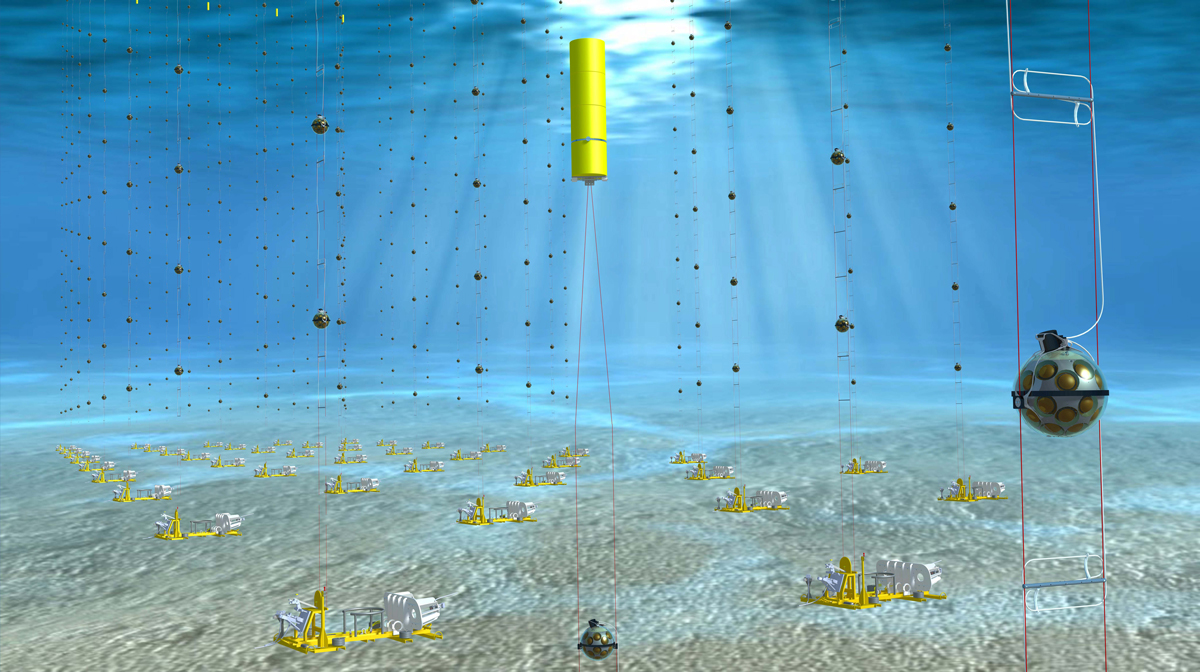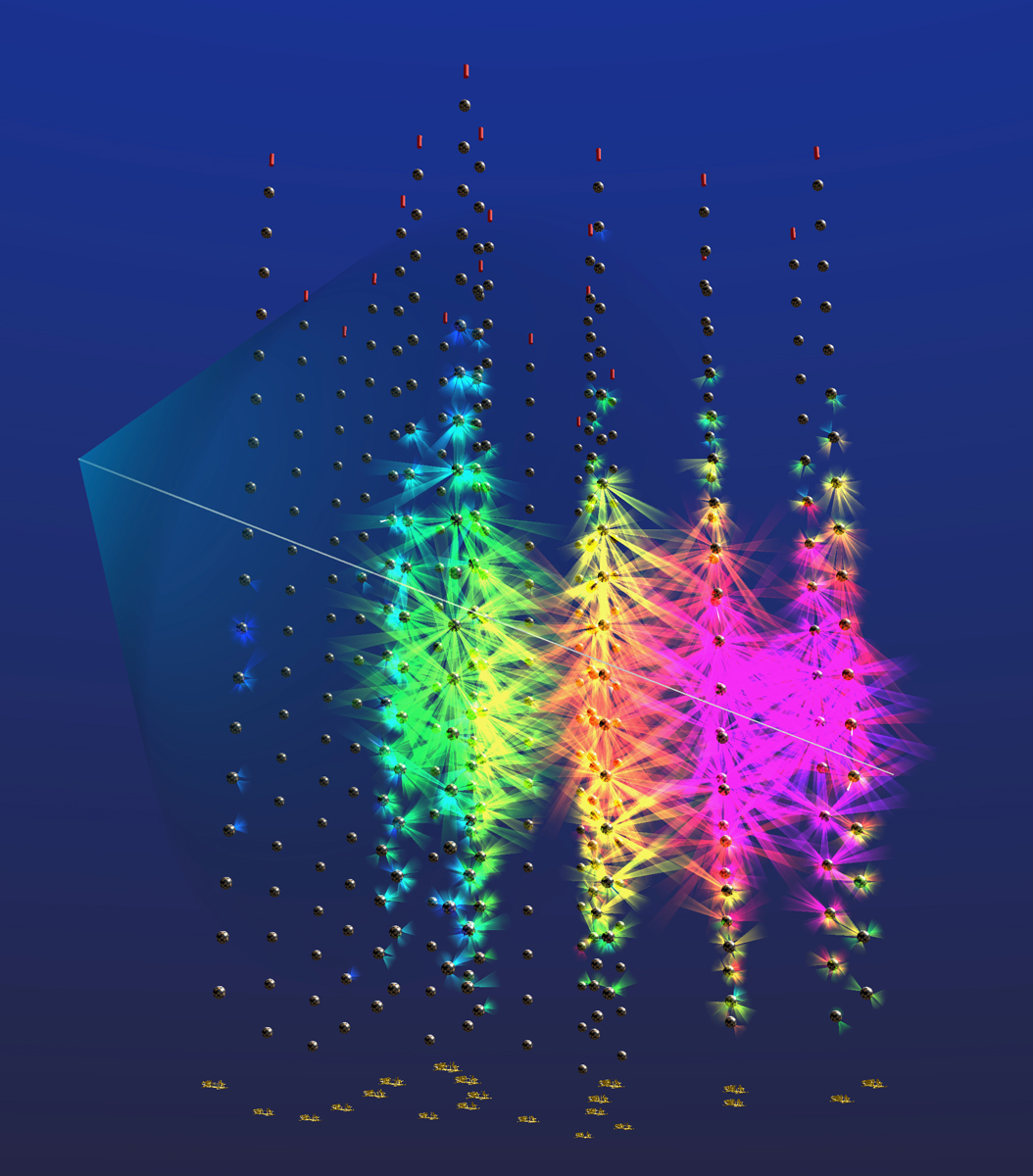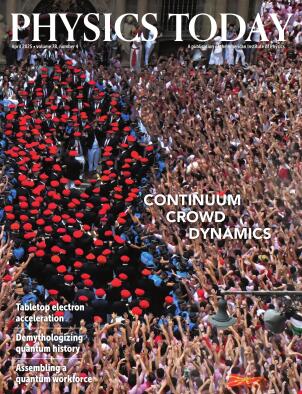Record-setting cosmic neutrino breaks in a new telescope
DOI: 10.1063/pt.uwwj.txjh

An array of sensors for the KM3NeT experiment is anchored to the Mediterranean seabed in this illustration. (It is much darker at these depths, 3.5 km below the surface, than depicted.) The detectors capture flashes of light emitted by muons and other particles that were produced in neutrino interactions. (Image copyright Edward Berbee/Nikhef, from KM3NeT/CC BY-NC 4.0

An incomplete neutrino telescope can still do the job when a can’t-miss particle shows up on its doorstep. Researchers with the Cubic Kilometre Neutrino Telescope (KM3NeT) report that their under-construction array of light sensors in the Mediterranean Sea has measured the signature of a neutrino that had on the order of 1017 eV (hundreds of PeV) of energy, making it the highest-energy neutrino ever detected. Analysis of the record-setting neutrino, which likely originated beyond the galaxy, could help astronomers understand the universe’s most powerful particle accelerators.
Neutrinos mingle with other matter exclusively via the weak force, and they do so rarely. Unlike charged cosmic rays, the electrically neutral particles are unaffected by magnetic fields and so travel in an unperturbed straight line from their sources. The challenge for doing neutrino astronomy is detecting the reclusive particles. To do the job, KM3NeT and similar projects deploy a vast network of light sensors in a transparent medium—in this case, Mediterranean seawater. Incoming neutrinos occasionally collide with water molecules to produce muons, electrons, and tau particles that travel so quickly in the water that they emit blue light known as Cherenkov radiation (see Physics Today, September 2023, page 13

The track of the unusually energetic muon detected on 13 February 2023 by the KM3NeT array was reconstructed by the arrival times of light at various sensors. Unlike many of the particles spotted by the detectors, the muon was traveling horizontally (right to left along the line). (Image from KM3NeT/CC BY-NC 4.0

Most detected neutrinos are produced in Earth’s atmosphere and rain down on the telescope with energies at the scale of teraelectron volts. But the extraordinary signal recorded in February 2023—when the array dedicated to neutrino astronomy was operating with just 21 of 230 planned lines of sensors—clearly did not stem from an atmospheric neutrino. The muon’s light saturated some of the telescope’s sensors, and it propagated not downward but horizontally. The researchers estimated the energy of the muon at about 120 PeV and that of the original neutrino at 220 PeV. Though there is considerable uncertainty in those estimates, the neutrino almost certainly packed more energy than the previous record holder, a roughly 10 PeV neutrino spotted by the IceCube Neutrino Observatory in Antarctica.
The exceptional energy of the neutrino suggests that it was produced, directly or indirectly, in a violent astrophysical process. The neutrino may have formed in a relativistic jet of material ejected by an active galactic nucleus or other powerful celestial accelerator (see the article by Francis Halzen and Spencer Klein, Physics Today, May 2008, page 29
The mystery of the neutrino’s source is tied to another: How lucky was it that KM3NeT, during a yearlong observing run with a skeleton of a detector array, snagged a particle that was more energetic than any cosmic neutrino that has been spotted during a decade-plus of searches by IceCube and other observatories? Using IceCube data, the KM3NeT researchers estimate that the detection of such an energetic neutrino with their small array is a roughly 1-in-70-years event. A more satisfying answer to the question requires pinning down the cosmic neutrino flux in coming years. IceCube, the still-in-progress KM3NeT, and other existing and planned neutrino telescopes will aid in that effort. (The KM3NeT Collaboration, Nature 638, 376, 2025
This article was originally published online on 21 February 2025.
More about the Authors
Andrew Grant. agrant@aip.org

